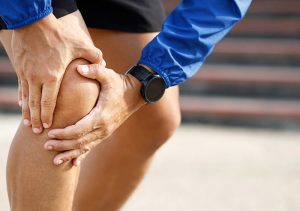How to Relieve Knee Pain
Knee pain is a common issue for people of all ages, whether they tend to be sedentary or active. Prior injuries and arthritis can lead to knee pain, but it’s generally caused by structural issues in your joints. However, that doesn’t mean you have to live with it! Physical therapy can help relieve your knee pain, regain functionality and function, and even make the muscles around the knee stronger to avoid future injury. Keep reading to learn more about relieving knee pain.
What is Chronic Knee Pain?
The knee is a complex joint, consisting of three bones- the femur, tibia, and patella (kneecap). Additionally, two menisci (a fibrous disc that sits between the bones) and many ligaments help keep the joint together. As humans age, conditions such as osteoarthritis can start causing pain. With so much going on, it’s no wonder an estimated 30 million Americans of all ages deal with knee pain!
How do you know if it’s knee pain versus chronic knee pain?
Chronic pain would be anything lasting more than six months and increases in severity over time. It generally occurs after someone has suffered an injury, surgery, or long-term damage to joints, muscles, or nerves. Chronic knee pain symptoms include constant swelling around the joint, limited mobility, sensitization/adaptation issues–which means your body changes how it responds to the stimulus–and decreased range of motion.
Knee pain is any localized pain around your knee joint. The most common cause of knee pain is overuse of the knee joint. This can be from sports, work-related, or even some medical conditions like arthritis. There are many signs of knee pain; some people may experience more than one.
Some common signs of knee pain include:
- Swelling
- Pain with Movement
- Pain when Sleeping
Both chronic knee pain and non-chronic knee pain can be treated by a physical therapist.
What are the Causes of Knee Pain?
As we mentioned, the knee is a complex joint. Therefore, there can be many causes or reasons for your knee pain.
Some of the most common reasons behind knee pain can include:
- Baker’s cyst: Accumulation of fluid behind the knee.
- Bursitis: Knee inflammation that results from overuse or injury.
- Dislocation: Kneecap dislocation due to injury or accident may cause lingering pain.
- Gout: Buildup of uric acid in the joint may cause arthritis and pain. It most commonly affects the big toe but can affect the knee as well.
- Meniscus tear: A rupture in one or more of the fibrous discs in the knee
- Rheumatoid arthritis (RA): An auto-immune condition that causes intense pain, joint deformity, and bone erosion.
- Osteoarthritis: A degenerative condition causing wear and tear of the cartilage in the knee joint
- Tendinitis: Inflammation of the tendons attaching the muscles to the knee joint and may cause pain in the front of your knee as you climb stairs or walk up an incline.
- Torn ligament: Knee ligament injuries are common; affected knee ligaments most often include the anterior cruciate and medial collateral.
One of our Breakthru physical therapists will be able to identify the source and cause of your pain. After an exam, they’ll provide you with a treatment plan and recommendations to help manage and treat your knee pain. The exact treatments and recommendations will depend on the cause of your pain.
How to Treat Knee Pain
In addition to working with one of our physical therapists, there are self-remedies that may help you get over the initial pain:
- Rest. Sometimes, just resting for a couple of days’ rest may be enough to heal a minor injury.
- Ice. Ice reduces pain and inflammation. Pro tip: don’t apply ice longer than 20 minutes at a time.
- Compression. The lack of fluid buildup in damaged tissues and the knee’s continued alignment and stability helps prevent further injury.
- Elevation. To reduce swelling, elevate your injured leg above the level of your heart. For example, if you are lying flat, be sure that your leg is higher than your chest.
Other treatment options for knee pain may include:
- Medications: A doctor may prescribe pain medications to help relieve the constant discomfort and to treat the conditions causing your knee pain.
- Physical Therapy: Physical therapy treatments may include different strengthening exercises based on the specific condition causing your pain. Our therapists will also help you regain mobility and strengthen your knee area.
- Injections: In some cases, injections directly into the joint may help, depending on the condition.
When Should I Seek Treatment for Knee Pain?
The following situations warrant a visit to our team and/or a physician:
- You can’t bear weight on your knee
- You feel unstable
- Your knee is swollen
- You have a limp
- You notice an obvious deformity in or near the joint
- You experience severe pain when moving the joint in addition to redness/swelling,
Why Choose Breakthru for Physical Therapy for Knee Pain?
If you’re looking for a physical therapy clinic to help you find a solution to knee pain, then Breakthru Physical Therapy center is the place for you.
Our team of experts in the field of physical therapy is here to help you get back on your feet with their experience and knowledge. At Breakthru Physical Therapy, we have the tools and experience to help you get back on track with your life.
We specialize in helping patients suffering knee pain due to an injury or illness. We also offer rehabilitation services for patients who have had surgeries or other procedures where they have lost mobility in their knee joints. Our physical therapists can provide treatment plans tailored to each individual’s needs so they can return quickly and safely to everyday activities.


